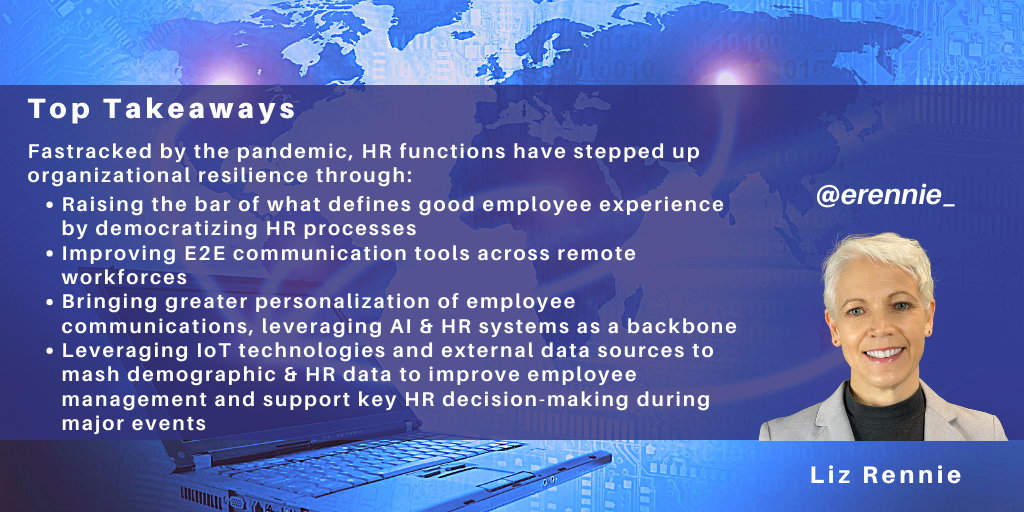posted on Jun 23, 2021 by Elizabeth Rennie

The last two years have challenged employees and HR teams in ways we could never have imagined, and many now have a new outlook on what “work-life balance” means. 2020 and 2021 have seen heightened resignation levels, and companies are only now starting to reflect on the impact of burnout on their employees. While vaccines are being rolled out, and with the threat of local breakouts of new variants continuing, companies are likely to continue to be cautious and invest in greater workforce management capability. They are likely to require more robust processes to support social distancing at work locations for many months to come as society adjusts to the post-pandemic way of living. In Q2 2020 alone, during the first pandemic peak in Europe, companies like Quinyx saw an incredible demand and reported 41 new signed customers, a 46% y/y growth rate.
Given the importance of this topic for the HR function, NelsonHall launched its first Workforce Management market analysis (full report available here). Some new HR themes emerged from this report that aims to help companies develop greater resilience. A couple of exciting developments are outlined below, with my reflections on whether they are likely to be lasting or not.
Democratized HR processes
Facilitated by technology, there is a growing trend for HR processes to be more democratized, enabling employees to have more of a say in defining what work suits them and when. This trend takes employee self-services to the next level of sophistication. For example, in the Workforce Management market, vendors have been increasingly enabling functionality to allow the employee to bid and auction shifts, swap shifts, and choosing when they work or go to the office. An example was a service center team that over 2020 enabled greater flexibility to support employee availabilities while allowing them to care for family members during COVID lockdowns. What used to be a leave process where you place leave requests is being adapted to support new attendance processes to enable employees to juggle work-life challenges.
My POV: democratized employee processes will grow. Where employee-to-employee interactions were traditionally managed informally face-to-face, with the backdrop of a larger share of the employee base working remotely, digital solutions are likely to identify opportunities to simplify processes through offering employee-to-employee connections increasingly. It will do this by formalizing what used to be informal interactions through richer democratized processes. These will increasingly appear across more functions and will continue to challenge and expand the concept of what makes up an “employee experience”.
Vendors that offer democratized shift swapping processes include ADP, Ceridian, Infor, Quinyx, SD Worx, TCP, UKG, and WorkForce Software. A number of these incorporate AI-based recommendations to fill the shifts. Shift auctioning is on the roadmap of several providers.
Direct communications
HR systems have traditionally not attempted to support E2E communications as this was the function of corporate emails or other means such as morning huddles. However, the pandemic necessitated a quick means of communication with remote or deskless workers who do not have email (e.g., delivery drivers). Workforce management systems stepped up to facilitate group communications so that messaging to people assigned to a particular shift or within a special grouping became much easier. The pandemic has raised awareness that direct communication tools are invaluable in a crisis. Many workforce management solutions now enable a click of a button to chat to everyone about to start a shift via a mobile.
My POV: Effective communications are critical for business resilience. The importance of communicating to large groups of employees based on work allocation, projects, location, and various other factors makes HCM and workforce management platforms ideal for offering this capability to organizations. For effective communications, personalization and employee preferences also need to be taken into account. Organizations can refine the level, type and style of communications based on employee preferences, job, location, and E2E needs. We expect HCM and workforce management technologies to increasingly drive a two-way communications approach, data rich and AI-supported across broadcasts, E2E, surveys, and chatbot communications.
IoT integration and data mash-ups
The importance of knowing your employees’ whereabouts in a crisis has been brought to light by the growing number of geopolitical, climate, and pandemic events. IoT and workforce management blended solutions offer the capability to ensure employee welfare while at work with geo-tagging/tracking, BLE tags for monitoring adherence to social distancing guidelines, and access restrictions based on thermometer checks. These are some of the complementary components of workforce management solutions that were implemented across 2020-2021. In 2020, many HCM providers (e.g., UKG, Workday) offered a new COVID mash-up report which mapped COVID outbreak data with employee locations.
My POV: Buildings have fire plans; to support remote workers, HR systems will increasingly step up and support greater health & safety features using IoT integration combined with external data sources to support significant events. Going forward, expect to see more business continuity functions embedded in HCM and workforce management platforms. A leading HCM and workforce management vendor, UKG, recently launched its Workforce Continuity Hub to support times of crisis with safety check-ins, a personal impact form, vaccine monitoring, and current crisis management where HR teams can create "events” (e.g pandemic/flood etc.) as they arise and track the event impact to enable a rapid HR response.
Find out more
Solutions will continue to evolve to help businesses adapt to a post-pandemic world. To find out more about what is happening in the workforce management market, NelsonHall’s HR Technology & Services clients can download our ground-breaking report in this field here. Alternatively, please contact Guy Saunders.
Buyers can also access NelsonHall’s Vendor Evaluation & Assessment Tool (NEAT) tool for Workforce Management that analyzes the performance of nine vendors offering workforce management technology. It is a suite of "speed-to-source" tools to assist strategic sourcing managers and HR technology executives in saving time and money while enhancing the quality of their workforce management technology sourcing decisions. The following vendors are included in this tool: ADP, Capita WFM, Ceridian, Infor, Quinyx, SD Worx, TCP Software, UKG, and WorkForce Software.




